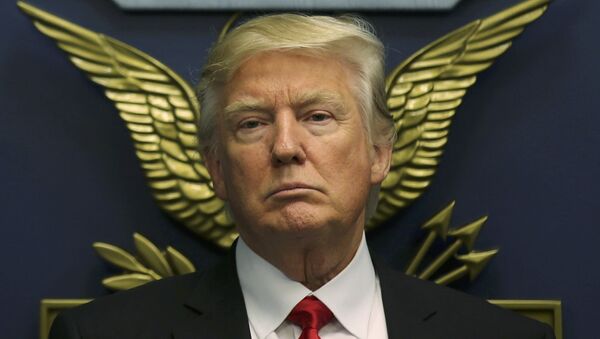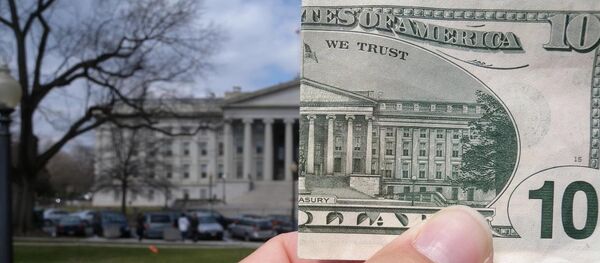Kristian Rouz – In the first two months of the Donald Trump presidency, the US national debt has decreased by $68 bln, or 0.3pc, without any substantial effort from the new White House administration.
After a $12-billion decrease in US debt in the first month of the Trump presidency, the burden of indebtedness has eased further in the second month since the inauguration. According to data by Gateway Pundit, on 20 January, US debt was $19,947 bln, whilst on 8 March, the figure decreased to $19,879 bln. Both publicly held debt and intragovernmental holdings have posted slight declines in dollar value.
As of 20 March, US debt stands at $19,849 bln, a decrease of another $30 bln. Even though the Treasury Department data indicate the ongoing and continuous accumulation of US debt, the dramatic dip in the value of US governmental bonds and the dollar FX rate fluctuations have produced the
‘Trump effect’ to national debt without the new president actually having undertaken any substantial effort to relieve the debt pressures yet.
"The massive debt is really a reflection of the unwillingness of our political leaders to make any tough decisions or deal with trade-offs," Maya MacGuineas of the Committee for a Responsible Federal Budget said. "It has become all too commonplace to borrow not for productive investments or for wherever we are in the business cycle… but because people don't want to pay the bills and have found it politically expedient not to do so."
How did such a massive reduction in the US debt happen? First of all, the election of Donald Trump as US President of November 8, 2016, was somewhat of a shock (albeit quite predictable) to financial markets. The benchmark 10-year US Treasury yield increased from 1.8261pc on November 7 to 2.1501pc on November 11, and extended the increase to 2.5pc on March 17. Increases in Treasury yields typically accompany declines in Treasury bond value, which have also been supported by the ongoing selloff of US governmental bonds by foreign holders.
"Net-net, Treasury flows were neutral to slightly positive," Gennadiy Goldberg of TD Securities in New York said.
US Federal Reserve has since twice increased its base borrowing cost from 0.25-0.5pc in November to the current 0.75-1.00pc. All these factors have resulted in a slight erosion of the value of the US national debt.
Ironically, the scary Trump figure has benefitted the fiscal stance of the US government before any fiscal policy measures have been announced. Trump himself, however, seems to be rather comfortable with debt, seeing leverage as a mere instrument that serves very utilitarian purposes.
"Yeah, I think – look. I have borrowed, knowing that you can pay back with discounts. And I have done very well with debt. Now, of course, I was swashbuckling, and it did well for me and it was good for me and all that. And you know, debt was sort of always interesting to me. Now we're in a different situation with the country. But I would borrow, knowing that if the economy crashed, you could make a deal. And if the economy was good, it was good. So, therefore, you can't lose. It's like, you know, you make a deal before you go into a poker game, and your odds are so much better," Trump said in a CNBC interview on May 5, 2016.
His proposed fiscal stimulus package – including lower income taxes and greater infrastructure spending – would inevitably contribute to an increase in US debt in the near-to-medium term. However, in the long run, as suggested by the Laffer curve model, lower taxes tend to generate greater tax revenues due to higher business activity and increases in the tax base. Besides, Trump-proposed customs tariffs (or border taxes) would make up for the loss of some of the internal revenues in the short-term, producing larger longer-term benefits if the policy stands.
Previously, Trump criticized the mainstream media for failing to report the decrease in US debt under his presidency thus far.
The media has not reported that the National Debt in my first month went down by $12 billion vs a $200 billion increase in Obama first mo.
— Donald J. Trump (@realDonaldTrump) 25 февраля 2017 г.
However, the only merit of Donald in regard to national debt is that he has influenced – by simply being himself and saying what he’s been saying – the bond market dynamics in a way that turned out to be beneficial for the US fiscal situation. In other words, Trump is changing the course of US economic development by manipulating his public image and the perception of him as a political figure by market participants.
In the long run, however, this approach of his will have to be backed by solid policy measures in order to be efficient. In the medium-term, the Trump administration is likely to increase borrowing, and the debt will most likely pass the $20 trillion threshold sometime in late 2017 – early 2018. Yet, the subsequent gains in fiscal revenues generated by the expected acceleration in domestic growth, and border taxation of foreign trade flows, might result in declines in the overall levels of the US national debt.





